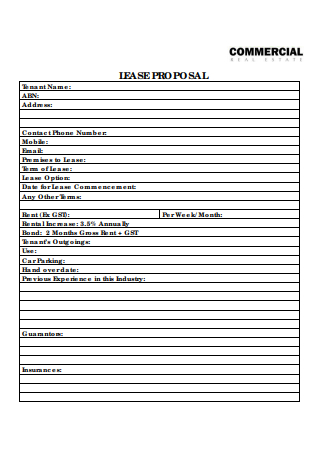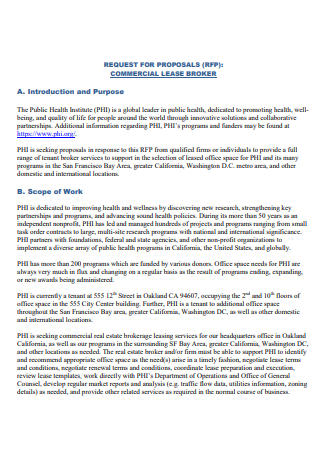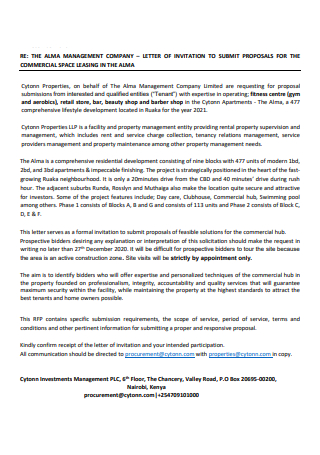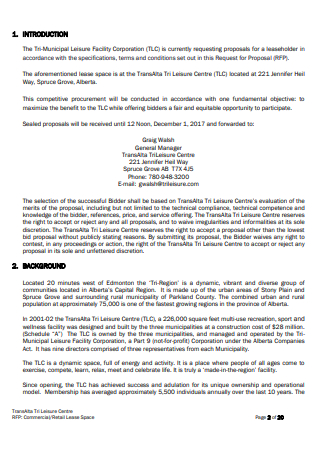4+ Sample Commercial Lease Proposal
FREE Commercial Lease Proposal s to Download
4+ Sample Commercial Lease Proposal
What Is a Commercial Lease Proposal?
What Type of Property Can I Use a Commercial Lease Proposal For?
What Should be Included in a Commercial Lease Proposal?
Is a Commercial Lease Proposal Legally Binding?
What Are the Listing Terms in a Commercial Lease Proposal?
Elements of a Commercial Lease Proposal
Steps in Writing a Commercial Lease Proposal
FAQs
Is commercial rent negotiable?
Do you need a business license to rent a commercial property?
Why should you never put money down on a lease?
What is the difference between a lease and a licence to occupy?
What Is a Commercial Lease Proposal?
In order for a legal tenancy to be established, a formal Commercial Lease Proposal must be signed. Despite the fact that an Offer to Lease might include certain lease conditions, there are other needs and provisions that must be addressed in a formal Lease Agreement. When it comes to commercial tenancy, an Offer to Lease is frequently the first step in the process, and it can be used to lay the groundwork for a Commercial Lease Proposal by stating some preliminary rental parameters such as the rent price and the day on which the lease term will begin.
Other templates are available on our website, and you can use them whenever you need them. They are as follows: business lease proposal, buyout agreement, work contract, Labor Contract, position agreement, fashion design proposal, business lease agreement, student production proposal, property purchase agreement, tenancy contract, consulting contract proposal, and other similar templates are available.
What Type of Property Can I Use a Commercial Lease Proposal For?
A commercial lease proposal, as opposed to a residential lease proposal, is typically used as a preliminary step in the leasing of business property rather than residential property. Commercial real estate consists of the following:
- Offices/Buildings
- Stores that sell goods to the public
- Restaurants/ Warehouses
- Spaces used for industrial purposes
- Spas, health clinics, and other similar facilities that do not fall into any of the defined categories are included here.
What Should be Included in a Commercial Lease Proposal?
Apart from the type of property and some personal information about the tenant and landlord (such as their names and phone numbers), a lease proposal should include the following information: the location of the property, its boundaries, and the permitted uses of the property; the start and end dates of the lease, which can also include a move-in date prior to the lease start date; rent details, such as how it is calculated, what costs are included, how taxes are paid, and how often the rent is paid; and the start and end dates of the The offer should also provide a deadline by which it must be completed. When an offer is not accompanied by a written acceptance, it is generally assumed to have expired after a reasonable period of time has passed. However, because what is considered “reasonable” might be susceptible to interpretation by a court of law and can differ from state to state, it is preferable to just give a specific expiration date. Unless otherwise provided, the party making the offer retains the right to withdraw their offer at any moment without cause or penalty. You should also see our project budget proposal.
Is a Commercial Lease Proposal Legally Binding?
Unbinding status can be granted to a commercial lease proposal that defines the fundamental features of a prospective Lease Agreement in sufficient detail. The implication of this is that if particular terms (such as the total rent) are agreed upon and approved by both the prospective tenant and the landlord, both parties are likely legally obligated by the terms. They will appear in the same format as they do now in the formal Lease Agreement. If the parties intend for the offer to be non-binding, they must make their intentions plain in the offer itself. It is recommended that you avoid mentioning any of the lease’s critical terms and conditions in the agreement.
What Are the Listing Terms in a Commercial Lease Proposal?
Having a clear idea of what you are giving and what you are willing to take is the most effective way to negotiate a successful agreement. The absence of written documentation makes it very difficult to argue later on that something was excluded from a lease that you believed was meant to be included in the agreement.
1. The Length of the Lease
If you wish to adjust the length of the lease terms, be specific about what you want to change. For example, do you want a two-year lease with three one-year renewal options (for a total of five years), or do you want a five-year lease with no renewal choices at all? It makes a significant difference in how long you will be tied down to a lease and how a landlord will react to additional terms you are requesting in a counter offer, both of which are important considerations.
2. The Property’s Present Condition
In the event that you are requesting the space “as is,” or if you require the landlord to perform repairs or improvements before you can move in. If you intend to renovate the property, please include a concise description of the anticipated changes. Because a landlord will frequently offer some sort of incentive or “allowance” if you renovate certain sorts of homes, you should make sure this is specified in your lease. You should keep your options open if you are unsure about the allowances you will receive for any modifications. Ask if you may submit more thorough information for renovations for the landlord’s review so that you can receive some sort of thoughts for upgrades. You should also see our information security proposal.
3. Date of Occupancy
Inform the landlord of the day on which you want to take physical possession (move in, gain access, or take responsibility for the property). There are rare instances when the day you take physical possession may be different from the date on which you will be required to begin paying rent. Using this example, you may request that the landlord set an occupancy date and rent start date of January 1, 20xx, while also requesting that the first month be rent-free in exchange for your cooperation. In this situation, the lease would commence on January 1, 20xx, and the landlord would be able to deduct the free month’s rent from the total amount owed to him. The tenant would be in the space for 12 months, and the lease would be for the same amount of time as well. You should also see our IT product proposal.
Elements of a Commercial Lease Proposal
Even if you are a sole owner, your proposal should be made on behalf of your company, not on your behalf as an individual entrepreneur. Your offer letter serves as a sales presentation for your company. You are requesting different terms that are more favorable to you, and you want the landlord to consider you and your company to be a good choice for the property. Whenever possible, the following information should be included in your proposal:
Steps in Writing a Commercial Lease Proposal
To lease a commercial space for your company, the following sample letter can (and should) be altered and used as either a first offer or a counteroffer, depending on the circumstances. It is not intended to serve as a substitute for legal counsel, but rather to demonstrate one method of expressing interest in leasing a specific location to those who are interested.
-
1. Create a Cover Letter for Your Commercial Lease Proposal
To get started, open a Word document in a new window and create a title page. Before sending the cover letter, make sure you have finished the title page of your proposal for a rental. Make clear why you’d like to lease this particular area and what you plan to accomplish with the leased property in your letter to the landlord.
-
2. Provide the Proposal’s Summary
Provide an overview of the lease proposal you’re submitting on the next page, which will be blank at this point. For example, this should include all of your organization’s aims and ambitions. Maintain brevity and focus on the essentials. You should also see our service contract proposal.
-
3. Give a Detailed Description of the Operations of the Tenant
Give a Detailed Description of the Activities of the Tenant Describe how things are going for your company right now. Background information on a topic might help readers get a better sense of who they’re working with and what they can expect.
-
4. Organize Your Audience’s Budget
Once you’ve specified your company’s operations in the contract sample, it’s possible to include the leased property’s cost summary in the contract sample. You can use a table to keep track of your spending as you’re filling in the specifics. You should also see our project investment proposal.
-
5. The Contract’s Terms and Conditions Should be Included in the Document
In order to comply with this provision, you must provide information about the location, the products and services of the tenant. Cost and anonymity terms should be explained thoroughly.
-
6. Mention the Advantages of Using a Commercial Lease Proposal
When everything else fails, make a list of what can be gained if the landlord agrees to the raise in rent. To list them, either use bullet points or simply number them. You should also see our business consulting proposal.
Sending an email with an attachment including the offer letter can be done by mail, hand-delivery, or by emailing the offer letter. Lessors and lessees alike might benefit from an agreement known as a Commercial Lease Proposal, in which both parties benefit from a beneficial rental arrangement.
FAQs
Is commercial rent negotiable?
In theory, a lease’s terms are negotiable Your ability to negotiate depends on the state of your nearby property market.
Do you need a business license to rent a commercial property?
Depending on the nature of your business, you may be required to present a license, identity, business registration, and additional business partners or owners.
Why should you never put money down on a lease?
Other reason to avoid making a down payment is that in the majority of states, you will be required to pay taxes on that quantity.
What is the difference between a lease and a licence to occupy?
A lease is a legal interest in land granted for the purpose of granting exclusive ownership for a specified period of time. A licence is nothing more than a personal authorization to inhabit or conduct anything on another person’s property.
The best way to secure a company lease is to conduct thorough research. The owner of the building, landlord, planning restrictions, environmental expectations, and nuisance legislation should all be considered. Make sure you understand your financial obligations, including how much you owe, what you’re responsible for, as well as how much your rent will rise annually. Utility, insurance, and maintenance costs are sometimes included in the monthly leasing payment; in other cases, they are all included in one flat fee. Decide how your lease will be transmitted in the event of your company closing or your relocation. Subleasing and assigning the lease are two instances of how a firm might be taken over by a new owner. Business owners that are interested in leasing a commercial space but aren’t sure they comprehend the lease agreement should refer to this page.





